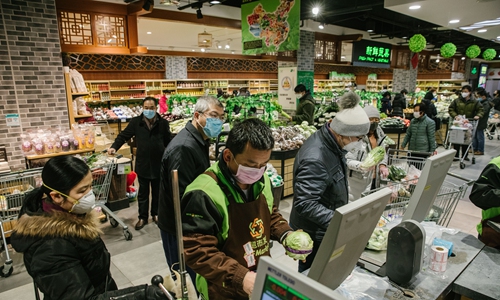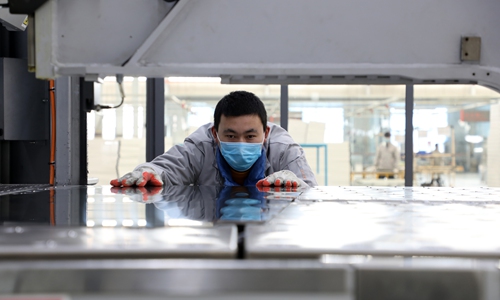HOME >> SOURCE
Economic activity picks up significantly across China
By Wang Cong Source:Global Times Published: 2020/2/25 1:03:40

Delivery staff resume work and send out parcels in Beijing. Photo: Li Hao/GT
Economic activity in China has picked up significantly as China enters into the third week since it mounted a top-down effort to revive the economy, with the rapid resumption of production in high-tech, less labor-intensive sectors and those essential to the fight against the coronavirus epidemic as well as the economy and people's livelihoods.Such progress highlighted the Chinese economy's resilience and the efficiency of officials in mitigating the economy out of a rather dark period.
However, despite promising signs, consumption, the biggest growth driver, remains vastly strangled. Many small businesses in the services sector still face threatening challenges, and fresh difficulties have arisen both at home and abroad for the manufacturing sector, as the epidemic outlook is worsening globally.
Economic data for February, which is anticipated to see a harsh impact from the epidemic, and even the first-quarter growth, will take a hard hit, analysts said on Monday. But economic activity will further pick up pace this week and in March a full recovery may not be seen until the end of the first quarter, they noted.
Faster pace
Larger industrial companies continue to take the lead in resuming productions nationwide, with some provinces such as East China's Zhejiang reporting that 90 percent of its major factories have resumed production. Traditional manufacturing powerhouses such as East China's Jiangsu and South China's Guangdong provinces also reported a more than 70 percent recovery in production at major industrial companies, according to the National Development and Reform Commission (NDRC) on Monday.
In terms of sectors, those essential to efforts in combating the epidemic, people's livelihoods and the economy, such as pharmaceuticals, energy and transportation, saw a much more pronounced pace in picking up production activities. Production of facial masks has reached 110 percent of its normal capacity, railroad capacity has reached 95 percent and coal production has resumed 76 percent, the NDRC said.
"There has been a series of good news in recent days about resumption of work and production across the country," Wei Jianguo, former Chinese vice commerce minister, told the Global Times on Monday, noting that progresses in some regions are particularly encouraging.
Overall, the recovery rate for economic activity nationwide is between 30 and 40 percent, slightly up from last week, according to analysis from the China Merchants Bank Institute. The rate for return trips also picked up 5.8 percentage points from the previous week to 33 percent.
"The resilience of the Chinese economy has been reflected upon as the epidemic has been relatively effectively contained," Liu Xuezhi, an economist at the Bank of Communications, told the Global Times on Monday.
Several developments last week also highlighted the resilience of the Chinese economy, particularly in the area of consumption, which contributes about 60 percent of China's GDP. Images of consumers lining up for dim sum in Guangzhou, Guangdong and tourists flocking to popular sites in Beijing and Hangzhou, Zhejiang, though widely criticized for their recklessness, showed the unabated spending power of Chinese consumers and predicted a potential spending spree after the epidemic.
Chinese consumers, who have been trapped at home for the past four weeks, are also believed to be a main part of the force that has substantially lifted the stock market, which is also a reliable indicator of the health of the economy.
As of Monday, the benchmark Shanghai Composite Index has gained 10.4 percent since February 3 and the smaller Shenzhen Component Index has edged up 20.4 percent.

People buy food in a supermarket in Beijing. Photo: Li Hao/GT
Grim situationHowever, even as investors cheered a stock market rally, some businesses particularly in the services sector around the country are still facing potentially life-threatening difficulties. Many restaurants, retail stores, hotels, and tourist sites across the country remain shut as strict anti-epidemic measures are still in place. There are many businesses that still cannot weather through this period and major reshuffles are set to follow, according to officials and analysts.
"In the retail, lodging and catering sectors, there will definitely be transformation and change," an official in Zhejiang, who spoke on the condition of anonymity, told the Global Times on Monday.
Aside from businesses that remain closed, some small factories that have resumed are facing new challenges, as their supply chain has been strangled due to the slow resumption of production in some parts of the country and foreign demand for their products faces risks.
"There are still a lot of restrictions, for example local governments in northern China are more conservative than those in the southern China," said a manager of a factory in Dongguan, Guangdong that produces magnetic material.
The manager, who spoke on the condition of anonymity, said that though the factory in Dongguan is ready for production, another one in North China's Inner Mongolia Autonomous Region is ordered to remain shut for another 25 days.
As such challenges persisted in recent weeks, Chinese President Xi Jinping on Sunday urged "precisive" measures for resumption of work and production and intensified efforts to support businesses and stabilize foreign trade and investments.
Xi said at a Sunday meeting that impact of the epidemic on the economy is short-term and is overall controllable and the long-term positive trend of the Chinese economy has not changed.

An employee at a kitchenware factory works on the production line in Binzhou, East China's Shandong Province on Sunday. Under the local government's guidance, companies have gradually resumed operations amid the COVID-19 outbreak. Photo: IC
Chinese factories and exporters are also worried about falling export orders, as the coronavirus poses serious challenges for many other countries and regions around the world. Even as China's efforts to contain the epidemic have shown remarkable results in places outside the epicenter Hubei Province, many countries such as Japan, South Korea and Italy are facing a worsening epidemic, raising concerns for potential damage to the global economy.All of this points to a still grim outlook for the Chinese economy in the short term and, although the pace for returning to work and production will pick up further, a full recovery might not arrive before the second quarter, analysts said.
In February, the manufacturing purchasing managers' index (PMI), a closely watched gauge of China's manufacturing activity, could fall back into territory of contraction, retail sales could see rare contraction, and exports could fall as much as 30 percent, according to Liu from the Bank of Communications.
The manufacturing PMI, which is expected to be released later this week, could plunge to as low as 36 this month from 50 in January, while the non-manufacturing PMI could fall to 44 from 54.1, according to a latest report from the Standard Chartered Bank.
However, even if GDP for the first quarter, which usually makes up about 22 percent of the full-year GDP, is hit hard, growth in the last three quarters could rebound to between 6 and 6.5 percent and the annual growth rate could still reach between 5.6 and 5.7 percent, according to a CITIC Securities report on Monday.
"We estimate that there will be a positive trend in the second quarter, starting with recovering consumption, investments in infrastructure and industrial production," Liu said, adding that supportive policies will also show effect in reviving the economy in the second quarter.
Yang Kunyi contributed to the story
Posted in: ECONOMY